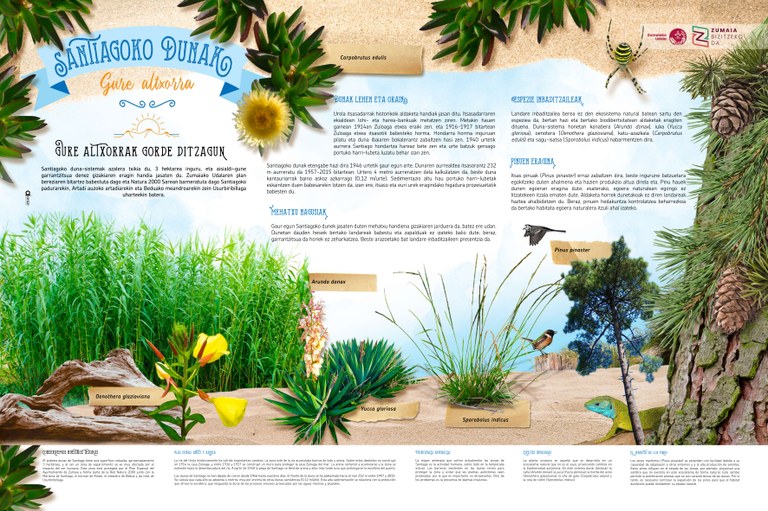3. Let's look after our treasures

LET’S LOOK AFTER OUR TREASURES
The Santiago dune system covers only a small surface area (approximately 3 hectares) and, since it is located in a recreational zone, is heavily impacted by humans. The area is protected by the Zumaia Local Council’s Special Plan and, alongside the Santiago Salt Marsh, the Artadi Holm Oak Grove, the Bedua Meander and the Usurbiribillaga Islands, forms part of the Natura 2000 network.
Dunes, before and now
The Urola estuary has undergone many transformations over the years. The eastern part used to be lined with mud and sand banks. In 1914, Zuloaga House was built on these deposits, and from 1916 to 1917, a wall was constructed to protect it from the sea. Sand began to accumulate and the dune spread towards the mouth of the river. From 1940 onwards, Santiago Beach began filling up with sand and years later, the town was forced to extend the breakwater protecting the port.
The Santiago Dunes have not stopped growing since 1946. Between 1957 and 2015, their leading edge moved 232 metres closer to the sea. Experts calculate that it moves a further 4 metres every year, a figure well above that recorded for other dunes along the Bay of Biscay coastline (0.12 m/year). This high sedimentation rate is linked to the protection afforded by the breakwater, which shelters the dunes from the erosive influence of sea and rainwater.
Principal threats
The greatest threat currently facing the Santiago Dunes is human activity, particularly during the summer months. The barriers erected in the dunes help protect the area and prevent native plant species from being trampled, which is why it is so important not to cross them. Another problem is the presence of invasive species.
Invasive species
An invasive species is a species that grows in an ecosystem that is not its own, triggering changes in the native biodiversity of the region. In this dune system, the principal invasive species include giant crane (Arundo donax), yucca (Yucca gloriosa), large-flowered evening-primrose (Oenothera glazioviana), hottentot-fig (Carpobrutus edulis) and smut grass (Sporobolus indicus).
The impact of pine trees
Maritime pines (Pinus pinaster) spread rapidly due to their ability to adapt to new environments and their high seed yield. These pine trees have an impact on dunes, casting shadows that would not normally be present in this ecosystem. This change has enabled the proliferation of plants that are not characteristic of a dune environment. It is therefore important to control the spread of these trees in order to enable the native habitat to return to its natural state.

 turismoa@zumaia.eus
turismoa@zumaia.eus
 Bulegoa
Bulegoa








